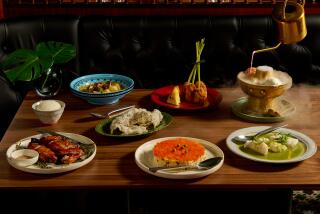Would You Like That With Fur, or Without?
Itâs October, springtime in Peru, a cool evening 11,000 feet up in the Andes. Iâm sitting at a rough wooden table in an adobe-walled restaurant in the town of Huancavelica, anticipating a very special meal. Our places are set with simple white plates, tiny paper napkins, forks and knives. The walls of the room are pink and turquoise. Tinny, festive huaynos, the folk music of Peru, drifts in from the kitchen along with aromas of cooking.
With me are my husband, Fred, and a fellow traveler named Reinhart, a big, solid Austrian cop we met aboard the rickety train up from the city of Huancayo. With some coaxing, Reinhart has agreed to share this very special meal.
Weâd spent the day on a glorious hike that took us along ancient Incan footpaths high above the town to where llamas grazed. At one point we gazed from a precipice in silent awe of the spectacular vastness of the altiplano world. It seemed only fitting that we cap the day with a very special meal of two Incan specialties: papas and cuy.
Twenty years ago, when I first met Fred, I loved hearing stories about the years heâd spent traveling from Alaska to South America--working on a salmon boat in Kodiak, helping to build a pottery workshop in rural Peru. The people he befriended and their places in the world and in his life became real enough to me that we talked about them as if they were old friends of us both.
He had a special chemistry with the Indians in Izcuchaca, a village close to Huancavelica, where he lived for a couple of years.
It became a dream of mine to visit this world, breathe its air, see its sights and eat its native food.
I was eager to try the many varieties of papas--potatoes--the Incasâ gift to the world. I was curious, but not terribly eager, about cuy--guinea pig--which is served only on very special occasions.
Fred had spoken of the drumsticks as his favorite part of cuy (pronounced koo-ee), so I pictured something like chicken. I could handle that.
He had ordered the food the day before, and the senora had greeted us with assurance that we were about to have a delightful meal, very special. Reinhartâs Austrian sensibilites did not extend easily to guinea pig, but he was game. And we had ordered plenty of excellent Peruvian beer.
We are the only customers in the restaurant, so when we begin to see movement at the kitchen door, we know our meals are up.
Reinhart is softly playing bongos on the tableâs edge, a smile on his face, when the kitchen door opens and the senora comes toward us carrying two steaming plates. Her teenage son follows, carrying two more. Beaming, the senora sets her plates before the men. Reinhartâs drumming abruptly stops. The son sets one plate in front of me and the other, heaped with potatoes, in the middle of the table.
There is what seems to be a long general silence, a kind of mini time warp, because the three of us are frozen in stunned observation of our food.
I look up at the senora, who jiggles her eyebrows twice at me, and her smile widens. I part my lips, but they wonât smile back. I look down at my plate. I canât take my eyes off this very special cuy. But I also donât want to see what I see: a critter about as long as a manâs size 13 shoe, lying on its back, its front split open like bypass surgery, front paws prayerful, staring up at me in a kind of startled way, mouth agape, two tiny buck teeth white and sharp, and his whole skinned self fried to a golden crisp.
âFrito,â says Fred, who prefers his cuy roasted. Maybe we can order something else.
âSi, senor,â replies our beaming senora. âProvecho!â (âEnjoy your meal!â)
âProvecho!â echoes her son.
And theyâre gone.
âMein Gott,â Reinhart says, mostly to himself. His hands are fully under the table. He looks at us, and I guess weâre looking at him in the same way. âI did not know it would be like this. I thought, like chicken, maybe. Pieces.â
âBaked pieces, maybe in a sauce,â I say.
Fred makes the first move, pushing against a little paw with a prong of his fork. âBig-time fried,â he mutters. He looks up. âSorry, guys. Itâs not like I remember. Doesnât seem to have much meat.â
âHow do we go about this, to eat it?â Reinhart has sweat beads on his forehead.
I think, if that creature grabs Fredâs fork, Reinhart will have a coronary.
A little friend from my past enters my thoughts, running in his plastic wheel late at night, hiding in his shredded newspaper by day. Barry was a hamster. Close enough. The ears, the nose, the tail, the toenailed feet sticking straight at me are very Barry.
Not even the papas look appetizing, but we each pile some on our plate and start probing and pulling at the cuy, cutting a little here, sawing a little there, having a little conversation, more than a little beer, and in a while, a pile of splintery bones begins to assemble on the center platter. We all agree thereâs not much more we can do with this. The anatomy is unfamiliar, and there are bits of meat on things. We think about appearing wasteful in a poor country, but, really, we canât eat another bite.
The senoraâs son shows up to ask how everything is.
âEsta bien,â we chorus, honestly. It is good--to be finished.
More to Read
Sign up for The Wild
Weâll help you find the best places to hike, bike and run, as well as the perfect silent spots for meditation and yoga.
You may occasionally receive promotional content from the Los Angeles Times.






